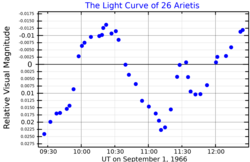| Observation data Epoch J2000 Equinox J2000 | |
|---|---|
| Constellation | Aries |
| Right ascension | 02h 30m 38.41727s[2] |
| Declination | +19° 51′ 19.0917″[2] |
| Apparent magnitude (V) | 6.10 - 6.15[3] |
| Characteristics | |
| Spectral type | A9 V[4] |
| U−B color index | +0.102[5] |
| B−V color index | +0.248[5] |
| Variable type | Delta Scuti variable[3] |
| Astrometry | |
| Radial velocity (Rv) | +15.0[6] km/s |
| Proper motion (μ) | RA: +79.814[2] mas/yr Dec.: −34.746[2] mas/yr |
| Parallax (π) | 13.7810 ± 0.0831 mas[2] |
| Distance | 237 ± 1 ly (72.6 ± 0.4 pc) |
| Absolute magnitude (MV) | 1.89[7] |
| Details | |
| Mass | 1.74[8] M☉ |
| Radius | 2.32+0.11 −0.12[2] R☉ |
| Luminosity | 15[7] L☉ |
| Surface gravity (log g) | 3.84[7] cgs |
| Temperature | 7,430[7] K |
| Rotational velocity (v sin i) | 186[9] km/s |
| Age | 1.075[8] Gyr |
| Other designations | |
| Database references | |
| SIMBAD | data |
26 Arietis is a variable star in the northern constellation of Aries. 26 Arietis is the Flamsteed designation; it also bears the variable star designation UU Arietis. The apparent visual magnitude of this star is 6.14,[5] which, according to the Bortle Dark-Sky Scale, is within the naked eye visibility limit in dark rural skies. The annual parallax shift of 13.78 mas[2] is equivalent to a distance of approximately 215 light-years (66 parsecs) from Earth. The star is receding from the Earth with a heliocentric radial velocity of +15 km/s.[6]
This is an A-type main sequence star with a stellar classification of A9 V.[4] It is a Delta Scuti variable[7] with a variability period of 0.0676 days and an amplitude of 0.010 in magnitude.[11] The star is around a billion years old with 1.74[8] times the mass of the Sun and 2.32[2] times the Sun's radius. The star is radiating 15 times the luminosity of the Sun from its photosphere at an effective temperature of 7,430 K.[7]
References
- ^ Breger, M. (March 1969). "Short-period variability of B, A, and F stars. II. Photometry of new Delta Scuti stars". The Astronomical Journal. 74 (1): 166–176. doi:10.1086/110788. Retrieved 27 October 2021.
- ^ a b c d e f g h Brown, A. G. A.; et al. (Gaia collaboration) (August 2018). "Gaia Data Release 2: Summary of the contents and survey properties". Astronomy & Astrophysics. 616. A1. arXiv:1804.09365. Bibcode:2018A&A...616A...1G. doi:10.1051/0004-6361/201833051. Gaia DR2 record for this source at VizieR.
- ^ a b Samus, N. N.; Durlevich, O. V.; et al. (2009), "VizieR Online Data Catalog: General Catalogue of Variable Stars (Samus+ 2007-2013)", VizieR On-line Data Catalog: B/GCVS. Originally Published in: 2009yCat....102025S, 1: B/gcvs, Bibcode:2009yCat....102025S.
- ^ a b Palmer, D. R.; et al. (1968), "The radial velocities spectral types and projected rotational velocities of 633 bright northern A stars", Royal Observatory Bulletin, 135: 385, Bibcode:1968RGOB..135..385P.
- ^ a b c Breger, M. (March 1968), "UBV and narrow-band UVBY photometry of bright stars", Astronomical Journal, 73: 84–85, Bibcode:1968AJ.....73...84B, doi:10.1086/110602.
- ^ a b Wielen, R.; et al. (1999), "Sixth Catalogue of Fundamental Stars (FK6). Part I. Basic fundamental stars with direct solutions", Veroeffentlichungen des Astronomischen Rechen-Instituts Heidelberg, Astronomisches Rechen-Institut Heidelberg, 35 (35): 1, Bibcode:1999VeARI..35....1W.
- ^ a b c d e f Paunzen, E.; et al. (September 2002), "On the Period-Luminosity-Colour-Metallicity relation and the pulsational characteristics of lambda Bootis type stars", Astronomy and Astrophysics, 392 (2): 515–528, arXiv:astro-ph/0207494, Bibcode:2002A&A...392..515P, doi:10.1051/0004-6361:20020854, S2CID 54666586.
- ^ a b c David, Trevor J.; Hillenbrand, Lynne A. (2015), "The Ages of Early-Type Stars: Strömgren Photometric Methods Calibrated, Validated, Tested, and Applied to Hosts and Prospective Hosts of Directly Imaged Exoplanets", The Astrophysical Journal, 804 (2): 146, arXiv:1501.03154, Bibcode:2015ApJ...804..146D, doi:10.1088/0004-637X/804/2/146, S2CID 33401607.
- ^ Royer, F.; et al. (February 2007), "Rotational velocities of A-type stars. III. Velocity distributions", Astronomy and Astrophysics, 463 (2): 671–682, arXiv:astro-ph/0610785, Bibcode:2007A&A...463..671R, doi:10.1051/0004-6361:20065224, S2CID 18475298.
- ^ "UU Ari". SIMBAD. Centre de données astronomiques de Strasbourg. Retrieved 2012-07-18.
- ^ Rodríguez, E.; et al. (June 2000), "A revised catalogue of delta Sct stars", Astronomy and Astrophysics Supplement, 144 (3): 469–474, Bibcode:2000A&AS..144..469R, doi:10.1051/aas:2000221, hdl:10261/226673.

